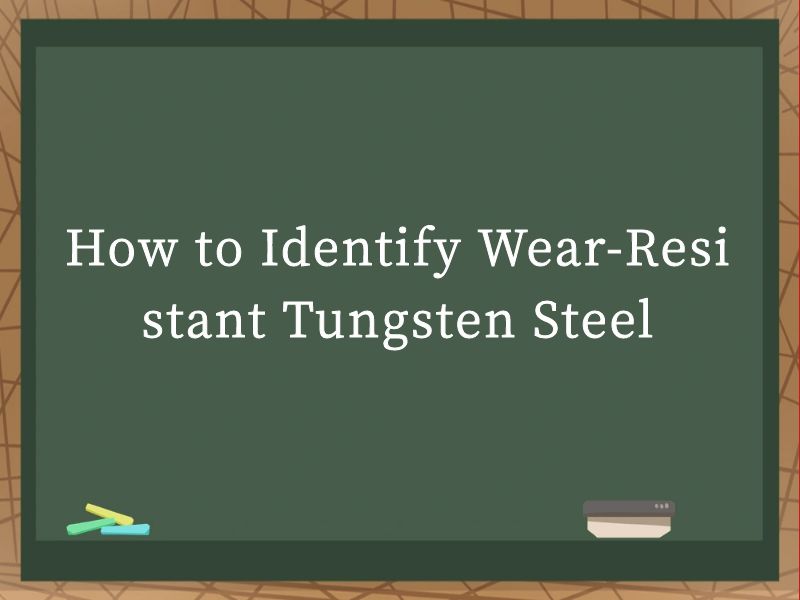JOURNALISM
- NEWS -
|
How to Identify Wear-Resistant Tungsten SteelHow to Identify Wear-Resistant Tungsten Steel.In the realm of materials science, wear-resistant tungsten steel stands out due to its exceptional durability and resistance to abrasive forces. This unique alloy combines the hardness of tungsten carbide with the toughness of a steel binder, making it indispensable in various industries ranging from mining and construction to machinery manufacturing. However, with the proliferation of suppliers and the complexity of material compositions, identifying genuine wear-resistant tungsten steel can be challenging. This article delves into the characteristics, testing methods, and practical considerations for verifying the authenticity and quality of this remarkable material.
Understanding the Composition and Properties Wear-resistant tungsten steel, often referred to as tungsten carbide-cobalt (WC-Co) or tungsten carbide-nickel (WC-Ni) composites, consists primarily of tungsten carbide (WC) particles embedded in a metallic binder. Tungsten carbide is renowned for its hardness, approaching that of diamond, while the binder provides the necessary toughness and ductility to prevent brittle fracture. The specific composition, including the WC particle size, binder type, and binder content, determines the material's overall performance in terms of hardness, wear resistance, and impact resistance. One critical aspect is the grain size of WC particles. Finer grains generally result in higher hardness and wear resistance but may compromise impact toughness. Conversely, larger grains enhance toughness but may reduce wear resistance. The binder content and type also play a pivotal role. Higher binder content increases toughness but decreases hardness, while cobalt binders offer better wettability and sintering properties compared to nickel-based binders. Visual and Physical Inspection The first line of identification involves visual and physical inspection. Genuine wear-resistant tungsten steel typically exhibits a dark gray to black appearance, with a metallic光泽. The surface should be relatively smooth, with minimal porosity or cracks. Any visible defects, such as large pores or cracks, can indicate poor quality or improper processing. Weight is another indicative factor. Due to its high density, tungsten steel is significantly heavier than conventional steels and cast irons. Comparing the weight of a sample with known dimensions to that of similar-sized materials can provide initial insights into its authenticity. Microstructural Analysis For a deeper understanding, microstructural analysis using optical or scanning electron microscopes (SEM) is invaluable. This involves preparing a polished cross-section of the material and examining its microstructure under high magnification. Genuine wear-resistant tungsten steel should exhibit a uniform distribution of WC particles within the binder matrix. Any clustering or uneven distribution can signify poor processing or contamination. Etching the sample with appropriate chemicals can further reveal the microstructure. Different etchants react with the binder and WC particles, highlighting their contrast and allowing for a clearer visualization of the particle size and distribution. Hardness Testing Hardness is a fundamental property of wear-resistant tungsten steel, and it can be measured using various techniques. The most common methods include Rockwell hardness (HRA, HRB, or HRC scales), Vickers hardness (HV), and Knoop hardness (HK) tests. For tungsten steel, the Rockwell A scale (HRA) is typically used due to its ability to accurately measure very hard materials. During a hardness test, an indenter of known geometry is pressed into the material under a specified load. The size of the indentation is then measured to determine the hardness value. Higher hardness values indicate better wear resistance. However, it's crucial to note that hardness is not the sole determinant of wear performance; other factors like fracture toughness and fatigue resistance also play significant roles. Wear Resistance Testing While hardness provides an indirect measure of wear resistance, direct wear tests are necessary for a comprehensive evaluation. These tests simulate the actual wear conditions the material will encounter in service. Common wear testing methods include pin-on-disc, ring-on-block, and taber abrasion tests. In a pin-on-disc test, a cylindrical pin of the material is rotated against a fixed disc under a specified load and speed. The weight loss or wear volume of the pin is measured to assess wear resistance. The ring-on-block test involves a rotating ring sliding against a stationary block, providing data on both sliding wear and friction coefficients. Taber abrasion tests use an abrasive wheel to rub against the material surface, simulating abrasive wear conditions. Impact and Fatigue Resistance Testing Wear-resistant tungsten steel must also withstand impact loads and cyclic stresses without failing. Impact tests, such as the Charpy V-notch test, measure the energy absorbed by the material during fracture. Higher absorbed energy values indicate better impact toughness. Fatigue resistance can be evaluated through cyclic loading tests, where the material is subjected to repeated stress cycles until failure occurs. The number of cycles to failure provides a metric for fatigue life. These tests are particularly important for applications involving dynamic loading conditions, such as drilling tools and mining machinery. Chemical Analysis Chemical analysis using techniques like X-ray fluorescence (XRF) or inductively coupled plasma-atomic emission spectrometry (ICP-AES) can confirm the elemental composition of the material. This is crucial for verifying the presence and proportions of tungsten, carbon, cobalt (or nickel), and any other alloying elements. X-ray diffraction (XRD) can further identify the crystalline phases within the material, ensuring that the desired WC-binder composite is present. Any unexpected phases, such as eta-phase (W2C), can indicate improper sintering or contamination, which can adversely affect performance. Practical Considerations and Supplier Verification When sourcing wear-resistant tungsten steel, it's essential to work with reputable suppliers who can provide comprehensive material certificates and test reports. These documents should detail the composition, hardness, wear resistance, and any other relevant properties. It's also prudent to request samples for in-house testing or to send them to an independent laboratory for verification. This ensures that the material meets the specified requirements and aligns with the intended application. Identifying wear-resistant tungsten steel involves a multi-faceted approach, combining visual inspection, microstructural analysis, hardness and wear testing, impact and fatigue resistance assessments, and chemical analysis. Each step contributes to a comprehensive understanding of the material's properties and quality. By working with trusted suppliers and conducting rigorous testing, one can ensure that the tungsten steel chosen is genuine, durable, and suitable for the intended application. This ensures not only the performance and longevity of the final product but also safety and cost-effectiveness in various industrial settings. |


